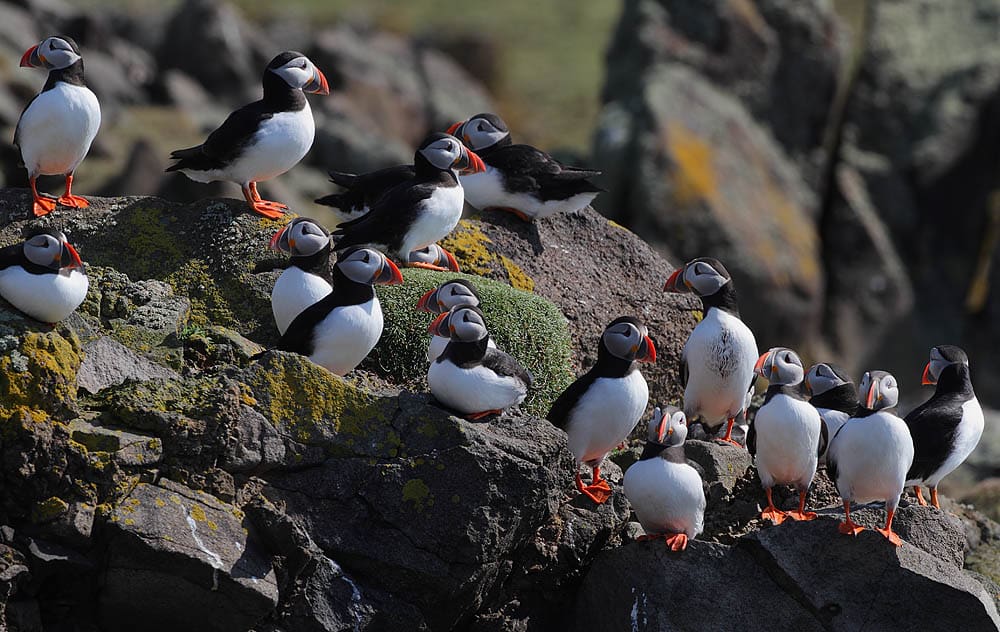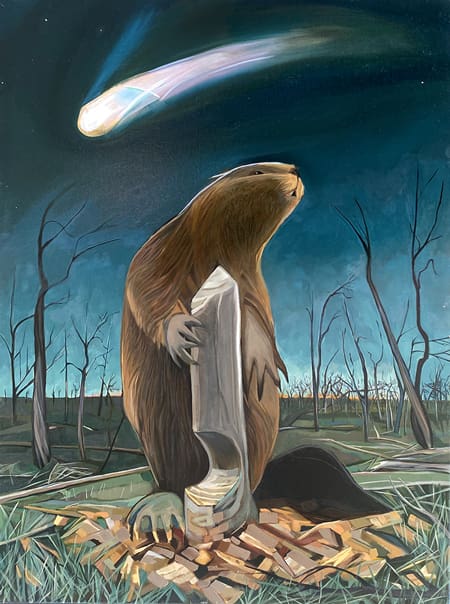What tiny creature glows in the dark, digests cellulose, and can propel themselves up to 20 times their body length in the air without even using their legs?
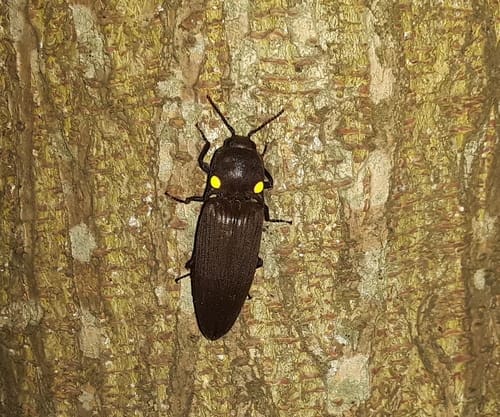
(CC BY-NC 4.0 via iNaturalist
II first discovered fire click beetles a few years ago while on a vacation to Florida in 2019. It was dark out, and my family and I sat at a firepit, joined by my younger cousins who we were visiting at the time. My brother and I had a tradition of catching fireflies, so we took our cousins to a grassy lawn bordered by trees and tall grasses on the other side of our hotel. Fireflies were dancing around in the air, and we had a lot of fun chasing them. I saw a light coming from the grass, and went towards it, thinking that trapping a firefly from below would be easier than jumping for one as it flew past me. I parted the grass to take a look, and saw that the glowing light wasn’t from a firefly at all!
At the time, I didn’t know that there were insects other than fireflies that could glow, much to my surprise. It was shinier than a firefly, without the characteristic red-yellow head, and the greenish glow was coming from two spots that looked like eyes! I didn’t try to pick it up, because I wasn’t sure if it would bite me, and instead went to share this unexpected finding with my parents. When I brought them over to see, it had disappeared. Later (with the help of Google, of course) I found out it was a click beetle; specifically, a fire click beetle (genus Pyrophorus). I had never seen one before. As someone who loves entomology, I started to read more, and I found them to be fascinating! Let’s take a look at what makes fire click beetles so unique.
Bioluminescence
As you know, fireflies are able to produce light, and fire click beetles are able to as well. Within an insect, the front section is the head, the middle section is the thorax, and the back portion is the abdomen. Pyrophorus has two glowing spots on its thorax, near the head. This beetle also has a spot underneath its abdomen, which is only visible when a beetle opens its wings to fly. These spots can glow yellow or green, and unlike fireflies, don’t really turn on and off. Fireflies can flash their lights at will, but fire click beetles cannot. These beetles can only control the brightness of their light at a given moment, changing intensity to adapt to the present environment and conditions. Fire click beetle eggs, larvae, and pupae glow, too!
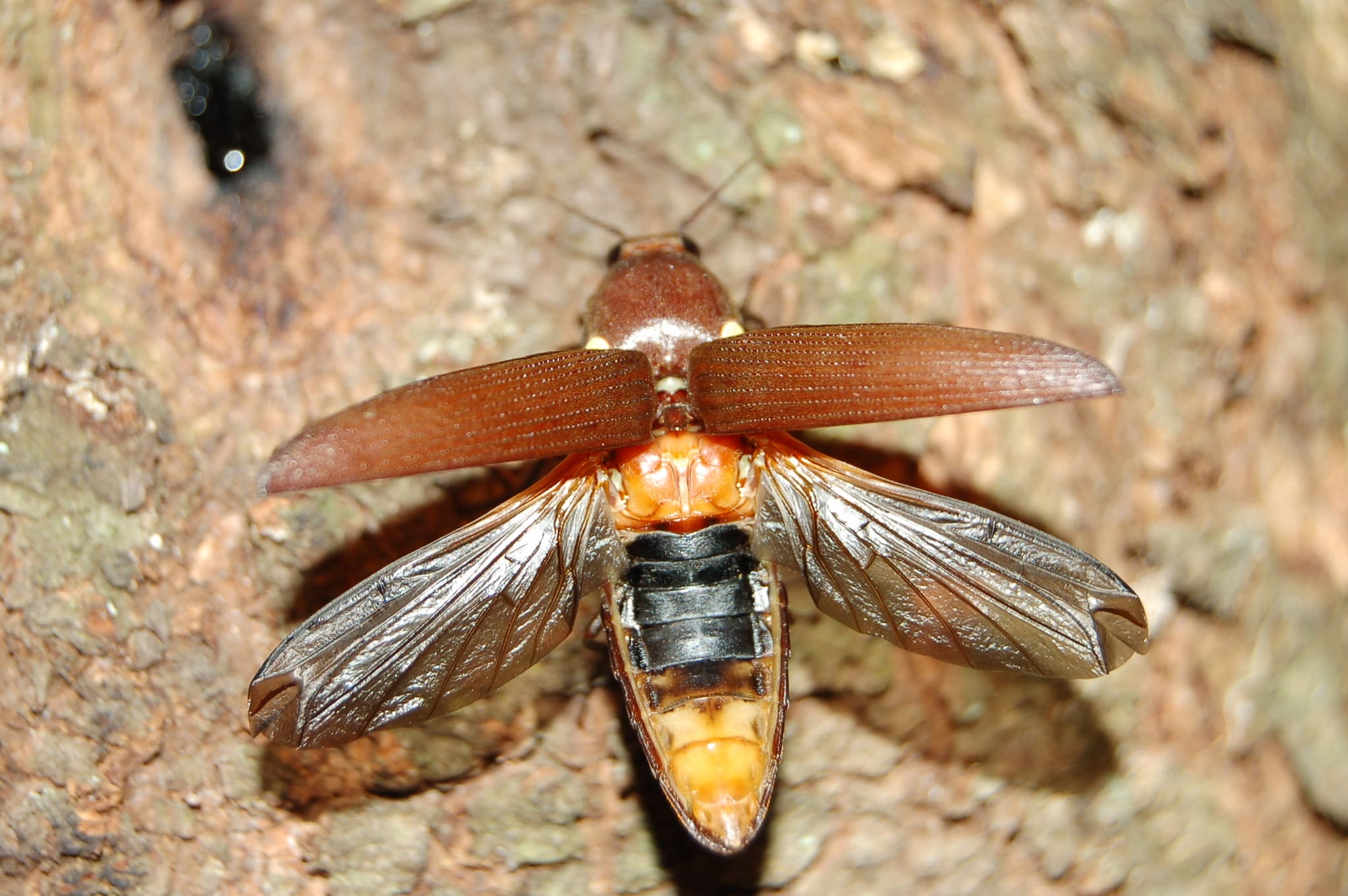
Fireflies and fire click beetles produce their light in the same way: a chemical reaction. Both creatures have glowing “light organs”, which have special cells that contain a molecule called luciferin. Luciferin is stable by itself, but if it breaks down in a certain way, the energy within the molecule is released as light. Enzymes help break this chemical down using oxygen; the main enzyme involved is called luciferase (the suffix -ase means that it breaks down its namesake chemical, luciferin).
Interestingly, fireflies and fire click beetles have varying genes for luciferase. Since enzymes are coded for by DNA, scientists were able to compare the genes of the two insects to see the similarities and differences. The DNA turned out to differ significantly! This result indicates that these two insects did not get their bioluminescence in the same way, since there isn’t a common ancestor that passed the ability down. Each evolved to have bioluminescence separately, and it ended up working the same way. It’s no surprise that luciferins are one of the most efficient ways to create light!
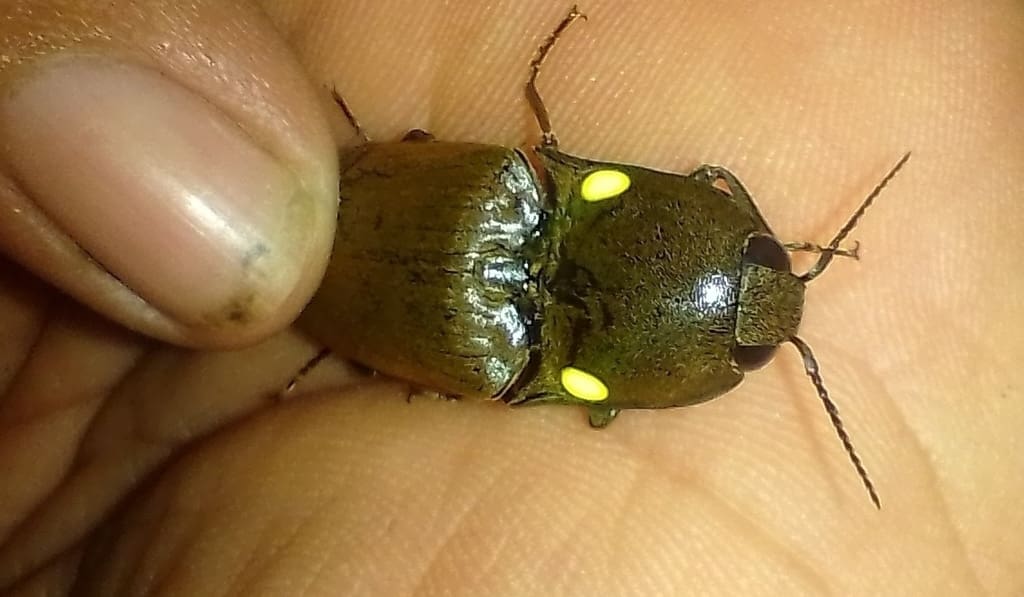
Janet Guardiola (CC BY-NC 4.0 via iNaturalist, image is rotated)
On a side note, the word “luciferin” has no direct correlation with the devil; lucifer is a Latin word meaning “light-bearing”. Luciferin, which produces light, was named by adding the suffix “-in”, which is commonly used for many molecules and compounds.
Clicking Powers
Click beetles (family Elateridae) – believe it or not – can click! They get their name from a loud and sharp snap they can produce. This sound is produced through a latch mechanism, where they build up energy that suddenly releases, propelling themselves in the air and releasing a click. It works kind of like snapping your fingers; when you press your fingers together, the friction between your fingertips keeps them from moving until enough energy has built up that it overcomes resistance, and your finger slips, making a snapping sound. Click beetles have a little notch at the base of their thorax that acts as a hinge; when they bend backwards, the notch slips into a latch that holds it in place. When they try to bend forwards, the pressure builds up until it, metaphorically, explodes.
Now, in your case, your middle finger (or whatever finger you use to snap), slips fast and hits your palm. Click beetles don’t have a release like this; instead, the force flings their whole body into the air (given how small they are, this doesn’t actually take that much energy; they’re usually only about an inch long). They can go up around twenty times their body length, and one species, Athous haemorrhoidalis, can “jump” up to a foot in the air.
This motion only works when the beetles are on their back. If they were standing normally, they would technically be propelled down into the ground. They use this technique to flip themselves over when they are stuck on their back. At the same time, if the beetle is in danger, it could also be used to get up and away from a predator much faster than if they tried to fly.
Fire click beetles have no extra mechanism for making sure they land right-side–up; most animals, if they fall, are able to at least somewhat orient themselves in the air. Fire click beetles, and most insects, cannot. Still, they land right-side-up 2 out of 3 times. How? Well, it is actually quite simple – they act like a weighted coin. Their underside is much heavier than their top, since their exoskeleton there is thicker and denser. Therefore, when they are falling, their bottom side tends to go first, and ends up below, where it belongs. Of course, this is not a foolproof method, as they still land upside down a third of the time. In that case, they can just do it again!
Why don’t fire click beetles get hurt when they fall? When they’re in the air, they accelerate very fast, up to 300 times the force of gravity. That’s fast enough to kill a human, but the beetles are not injured at all – with the capacity to crawl and fly immediately. This ability is a result of their hard exoskeleton that protects them on the outside, and their soft tissue inside, which is designed to absorb impact to avoid internal damage. Coupled with their size, this structure allows most smaller insects to survive their terminal velocity. This means that, if you dropped one from as high as an airplane, it would survive the fall! (risks from air pressure, wind speed, or an unlucky bird encounter notwithstanding).
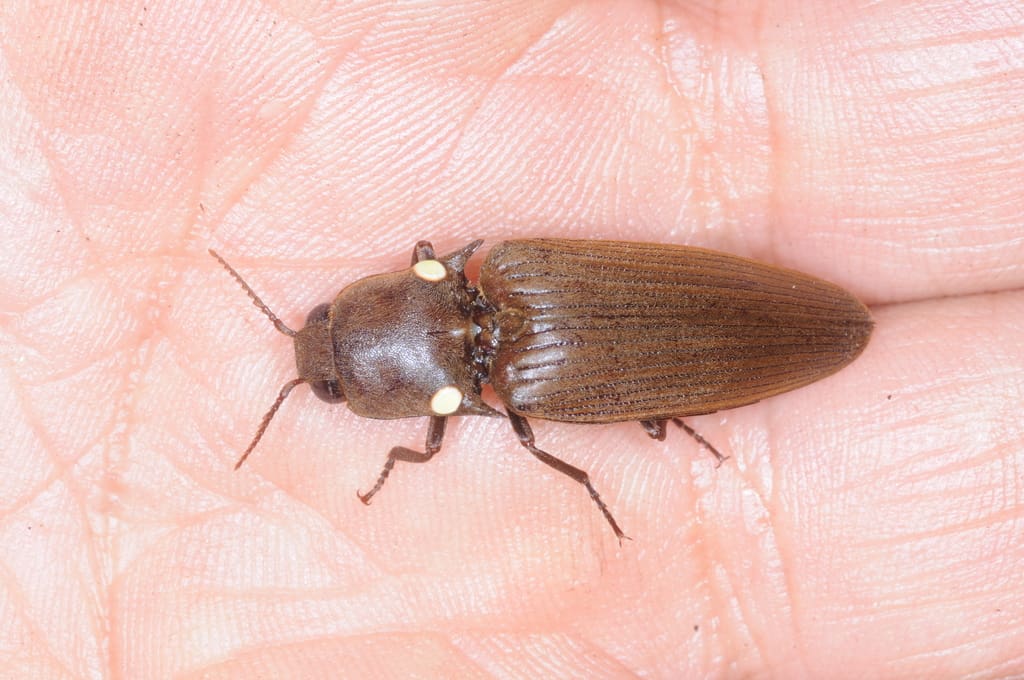
Role in the ecosystem
Fire click beetle larvae live in soil or decaying wood, where they feed on a mix of decomposing plant material and small invertebrates. In this way, they help recycle nutrients in their ecosystems. Adults of some click beetle species feed on pollen, nectar, and occasionally soft-bodied insects, though the diet of Pyrophorus adults is bit less well documented.
It’s worth talking here about cellulose, for a minute, a carbohydrate found in the lining of plant cells. Cellulose is one of the main “leftover” materials that needs to be broken down in the environment, since other animals only tend to digest proteins, lipids, and certain carbohydrates. Cows, for example, also have the right enzymes and gut microbes to digest cellulose; that’s why they can rely on grass as a food source, unlike humans. In our diets, cellulose is typically a fiber; we do not get energy from it, but it helps us in other ways (including helping digestion go smoothly, and helping diversify our gut microbes). However, these beetles are believed to tolerate and digest cellulose rather easily.
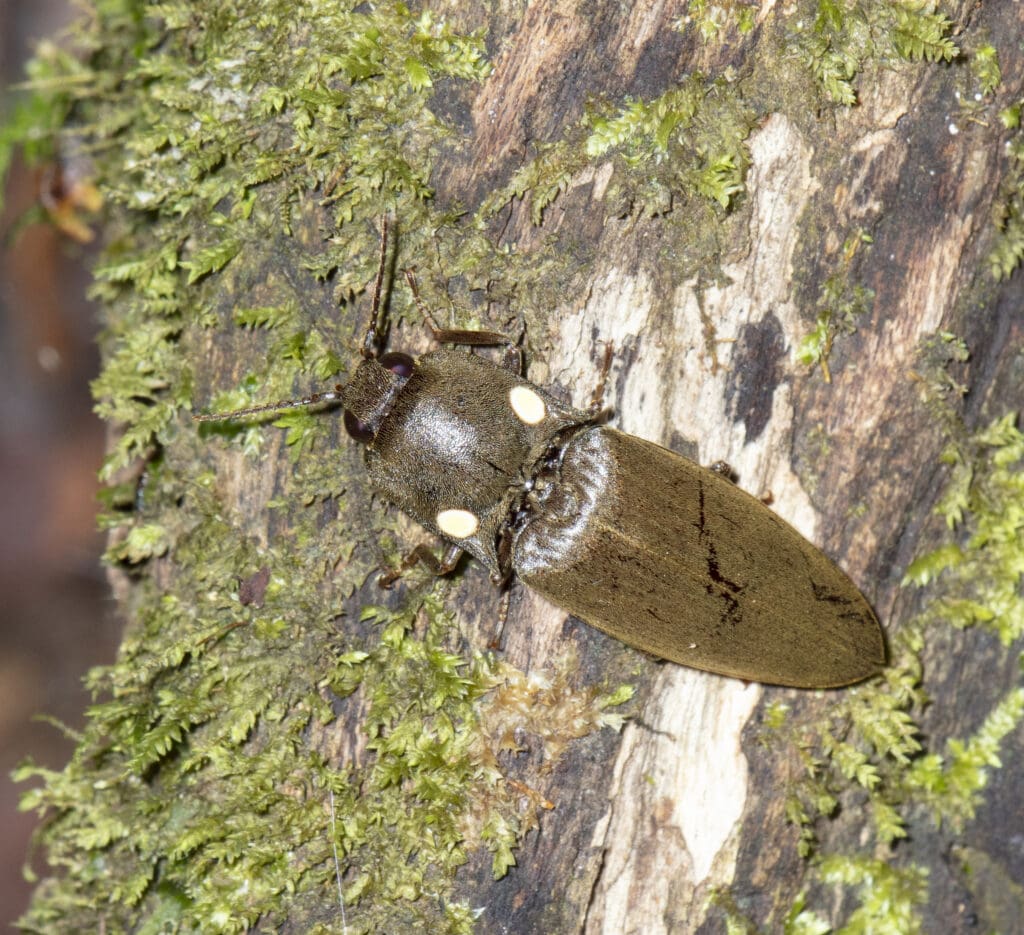
Since fire click beetles often eat pollen and plant matter, warm, leafy areas like the tropics, subtropics, and temperate regions are a favorite. They can be found in Central and South America, as well as the surrounding islands. They can even be found as far north as Mexico or, rarely, southern US, although they have recently been disappearing from there, along with many other insects in the area. Habitat loss and deforestation, pesticide and herbicide use, and temperature and precipitation variations due to climate change are some of the major contributors to fire click beetle disappearance. These beetles are usually referred to as cocuyos in areas south of Florida.
Also, remember when I mentioned aphids before? Some fire click beetle adults eat them, as well as other soft-bodied pests. This predator-prey relationship keeps aphid populations in check. Other species play a role in managing fire click beetle populations, such as large insects, moles and shrews, and some birds, which are all common predators of Pyrophorus.
Every species in an ecosystem has a specific role to play in the flow of energy and cycling of nutrients. Some of the main roles in a food web are producers, consumers, and decomposers. If any of these groups become too abundant or too small, the ecosystem might become unstable. A trophic cascade is a series of impactful and often harmful effects in a food web caused by a change in one of the populations in the ecosystem; the addition or removal of just one species causes the entire thing to fall apart.
For example, if most of the fire click beetles in a certain environment suddenly died, aphid populations could grow exponentially. This action could cause other harmful effects, starting with the death of plants that the aphids feed on. Animals that feed on the click beetles might also decrease in size, as they would lack this creature as a food source. In turn, other species those animals eat would increase in size, and the ecosystem would become unstable.
These potential consequences present the main reasons why it’s concerning that these beetles, and other insects and animals, are disappearing from certain locations. Climate change and human activities are causing ecosystem instability at much faster rates than usual, which puts environments at risk.
The potential for this kind of ecosystem collapse is part of the reason why invasive species or endangered species are such a big deal. Ecosystems are interconnected, and the presence or absence of a given species has the power to entirely change or destroy how other organisms interact with the environment.
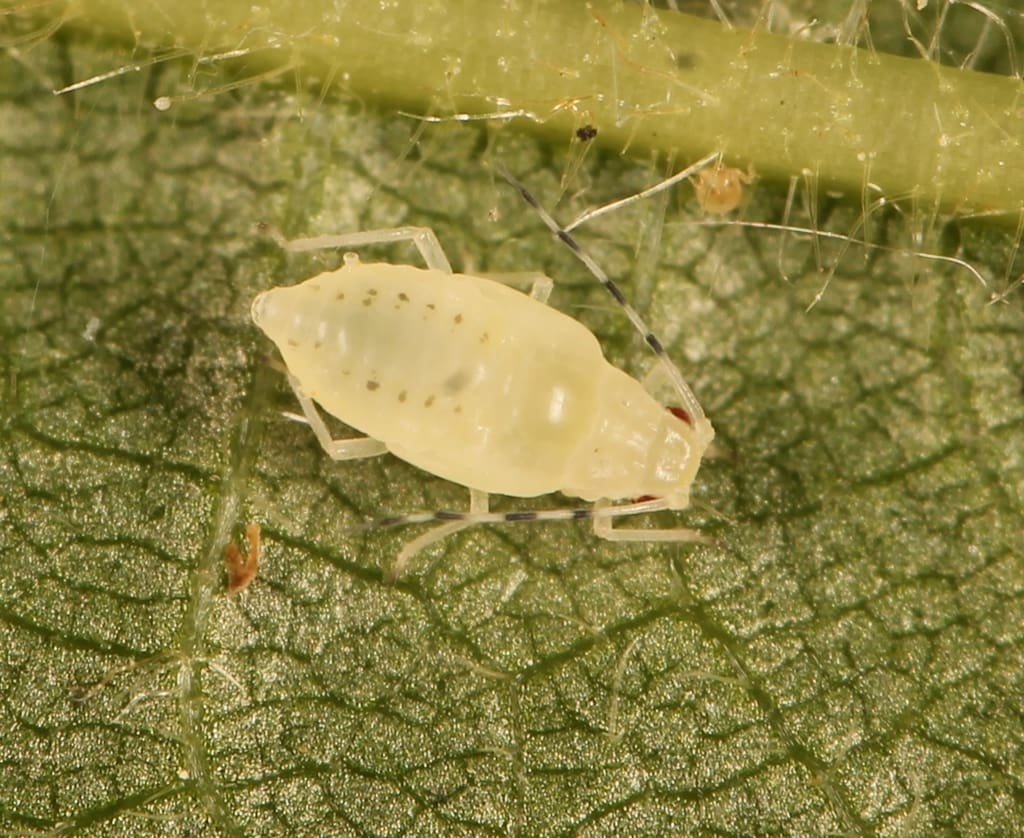
I hope you’ve learned a little about a fascinating tiny insect that I love, and their weird features like bioluminescence and clicking. I also hope you’re more knowledgeable about the important roles species play, which are often critical to maintaining a stable ecosystem. Decomposers and little critters that feed in the soil are necessary for the flow of energy and nutrient cycling through an ecosystem. Consumers, like the adults, help keep populations in check and maintain a balance between different species.
I hope this introduction to the fire click beetle encourages us to dive into any curiosities we have, like I did with these beetles. I also hope that this reflection helps us become more aware of the natural world and our place in it, and consider how we affect other species and individuals in our ecosystem.

Anya Reddy is a high school student at Blue Valley North. She loves biology and biochemistry, as well as entomology, ecology, and environmental science in general. Some of Anya’s non-science passions include archery and all kinds of 2D and 3D art. She enjoys learning about all kinds of organisms and how they connect and interact with others in their environment; she hopes to use writing to help share fascinating details about them, helping others like the weird and interesting organisms she loves.
Dig Deeper
- The Chemistry of Bioluminescence (Toshio Goto)
- Latching of the click beetle (Coleoptera: Elateridae) thoracic hinge enabled by the morphology and mechanics of conformal structures (Ophelia Bolmin et al.)
- Trophic Cascades: The Unexpected Effects (Matt, Mossy Earth)
- Jumping without Using Legs: The Jump of the Click-Beetles (Elateridae) Is Morphologically Constrained (Gal Ribak and Daniel Weihs)
- Firefly genomes illuminate parallel origins of bioluminescence in beetles (Timothy R. Fallon et al.)

